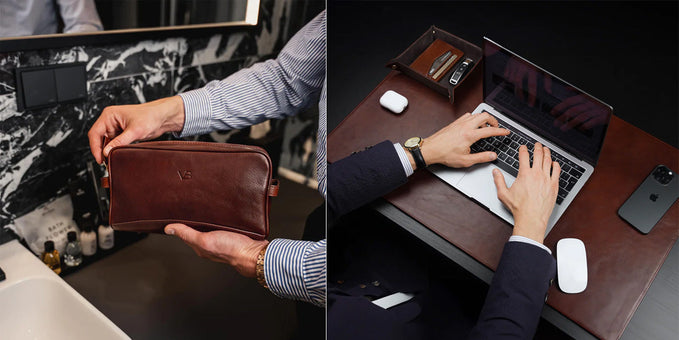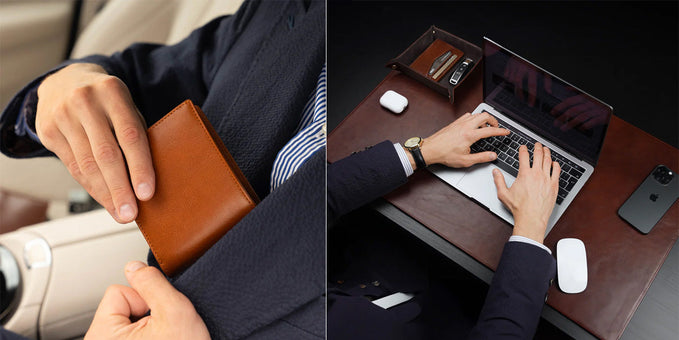How Does RFID Work?

RFID stands for Radio Frequency Identification technology.
It involves an RFID tag and a transponder.
These can communicate wirelessly with each other.
This is used to allow transactions without the need to type anything into any device. It is an easy tap-and-go system.
RFID-blocking technology stops thieves from skimming your cards when they're in your wallet (all Von Baer wallets come with this as standard).
Step-by-Step Breakdown of RFID Technology
- An RFID system begins with the tag. The tag is simply a microchip and antenna. When a reader is within range, the tag picks up its signal and is activated.
- The activated tag then transmits the data stored on it.
- The RFID reader then receives the data via its own antenna.
- The reader then decodes the data, converts it into a readable format, and sends it to the central system to be processed.
- The central system processes the data as needed. For example, to enact a retail transaction, a record of the sale, and an adjustment in the inventory count. During this process, the system may confirm the user’s identity before unlocking resources.
Advantages of RFID Over Traditional Methods

- Speed and Efficiency: RFID allows for very quick transactions and is, therefore, very useful not only in retail but also in public transit and low-level security check situations.
- Durability and Reliability: RFID tags work well in adverse weather and are resistant to physical wear.
- Ease of Monitoring and Tracking: RFID systems can easily track multiple cards using apps that take up no added space, and are as near as your phone.
- Automation and Error Reduction: Manual entries often contain errors, but RFID technology ensures accurate data exchange to a high level of complexity and accuracy.
- Data Storage Capacity: RFID tags can hold a broad range of data including ID, comprehensive medical records, and more.
- Integration with IoT: RFID integrates seamlessly with IoT (the Internet of Things), which is useful for integrating into your smart home system. It’s also capable of helping city infrastructure and automating personal device management.
- Personalization and Scalability: RFID systems can be fully tailored, resulting in a flexible, customizable, tool that scales easily to user demands.
- Contactless Operations: Safer, healthier public engagements are achieved through minimizing physical contact between members of the public. This reduces risks like virus transmission.
- Cost-Effectiveness: Finally, the reliability and ease of the RFID system result in long-term financial benefits. The system is robust and stable over a long time period, justifying any cost involved.
Practical Uses of RFID Technology

RFID technology is all around us, in diverse situations, through a variety of real-world applications.
Let’s explore them:
Contactless Payments
RFID is the key to contactless credit and debit cards.
Tap your card near a point-of-sale terminal, and the chips, antennae, receivers, and backup system do the rest.
Quick, easy, and secure transactions at the tap of a card.
Travel Convenience
RFID chips are now incorporated in many passports, reducing fraud and illegal travel and making your experience easier and smoother at international border crossing pinch points.
Though not yet used for boarding passes (at the time of this writing), the technology has markedly improved travel security.
Supply Chain Management
RFID tags are used to track inventory movement and storage, allowing supply chain systems to work more efficiently and effectively.
This reduces the chances of running out of a particular product at a specific location when it is needed by a customer. In other words, items are more likely to be there when you want them.
Healthcare Efficiency
Hospitals are leveraging this technology to great effect as well, using it to track equipment and even patients.
RFID wristbands ensure that patients get the best care for their particular situations and needs, and the reduction in administrative errors can actually save lives and improve conditions for individual patients (source).
RFID also ensures that equipment is properly cared for, and is where it needs to be when called for.
Event Management
Large-scale events, like concerts, sports events, and conventions, use RFID wristbands to increase entrance security, streamline payment and crowd management, and ensure that attendees have the best time possible, with the least amount of risk or inconvenience.
Security Access
RFID cards are used at security checkpoints in restricted areas.
Because they are so versatile, one system can handle various levels of clearance and specific access to a variety of areas by certain individuals – and they can keep track of where people are at a given time for both security and safety concerns.
Benefits of RFID-Blocking Technology in Wallets
RFID is a very useful technology, making our lives easier and more secure and protecting us in various situations.
However, sophisticated thieves sometimes leverage this technology for negative purposes – this is called skimming.
Such thieves can access your financial and personal data without you even knowing it.
Unless, of course, you are protected.
This protection consists of a simple barrier built into your wallet that blocks the electronic signals required to steal your information.
You can still use the RFID technology when you need it, but when you don’t need it, it is tucked safely away behind its shield.
Image: Money Clip Wallet (link)
Note: All Von Baer wallets come with RFID-blocking technology built-in as standard. See them here.
Let’s look at the benefits of this RFID-blocking technology.
1. Enhanced Security Against Identity Theft
RFID-blocking wallets have a material built into the outer surface that blocks the signals necessary for the exchange of data.
The data protected can include ID information, credit card numbers, and other key data.
You won’t know when it blocks an attack, but you will know you are protected if any such attacks should occur.
2. Peace of Mind During Travel
These thieves often frequent airports, train stations, retail centers, and other high-traffic areas where people are more likely to have money to spend, and are more likely not to miss money for a while after it has gone missing.
3. Long-Term Financial Safety
Since some thieves take the information and delay their attack, taking small amounts out over longer periods of time, many victims don’t even notice that they are being stolen from.
These amounts add up over time, though.
Add this to the risks of identity theft, and a little added investment in this technology is clearly a good idea.

Author: Igor Monte
Igor Monte is the co-founder of Von Baer. He's an expert in all things premium leather, from being an end-user right up to the design and manufacturing process. His inside knowledge will help you choose the best leather product for you.
We strive for the highest editorial standards, and to only publish accurate information on our website.
Leave a Comment
Your email address will not be published.







